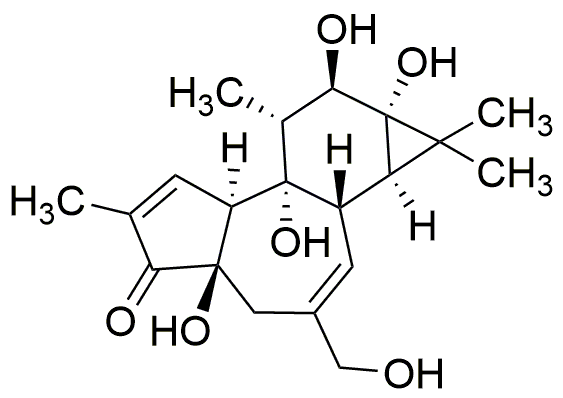Phorbol is widely utilized in research focused on:
- Cancer Research: Phorbol esters are known for their role in promoting tumor growth in certain cancer models, making them valuable tools for studying cancer biology and testing potential therapeutic agents.
- Signal Transduction Studies: This compound acts as a potent activator of protein kinase C (PKC), which is crucial in cell signaling pathways. Researchers use it to investigate cellular responses and signaling mechanisms.
- Inflammation Research: Phorbol is often employed in studies related to inflammation, helping scientists understand the underlying mechanisms and develop anti-inflammatory drugs.
- Pharmaceutical Development: Due to its biological activity, phorbol derivatives are explored for their potential in developing new drugs, particularly in oncology and immunology.
- Neuroscience Applications: Researchers utilize phorbol to study its effects on neuronal signaling and plasticity, contributing to our understanding of neurodegenerative diseases and cognitive functions.
General Information
Properties
Safety and Regulations
Applications
Phorbol is widely utilized in research focused on:
- Cancer Research: Phorbol esters are known for their role in promoting tumor growth in certain cancer models, making them valuable tools for studying cancer biology and testing potential therapeutic agents.
- Signal Transduction Studies: This compound acts as a potent activator of protein kinase C (PKC), which is crucial in cell signaling pathways. Researchers use it to investigate cellular responses and signaling mechanisms.
- Inflammation Research: Phorbol is often employed in studies related to inflammation, helping scientists understand the underlying mechanisms and develop anti-inflammatory drugs.
- Pharmaceutical Development: Due to its biological activity, phorbol derivatives are explored for their potential in developing new drugs, particularly in oncology and immunology.
- Neuroscience Applications: Researchers utilize phorbol to study its effects on neuronal signaling and plasticity, contributing to our understanding of neurodegenerative diseases and cognitive functions.
Documents
Safety Data Sheets (SDS)
The SDS provides comprehensive safety information on handling, storage, and disposal of the product.
Product Specification (PS)
The PS provides a comprehensive breakdown of the product’s properties, including chemical composition, physical state, purity, and storage requirements. It also details acceptable quality ranges and the product's intended applications.
Certificates of Analysis (COA)
Search for Certificates of Analysis (COA) by entering the products Lot Number. Lot and Batch Numbers can be found on a product’s label following the words ‘Lot’ or ‘Batch’.
Numéro de catalogue
Numéro de lot/série
Certificates Of Origin (COO)
This COO confirms the country where the product was manufactured, and also details the materials and components used in it and whether it is derived from natural, synthetic, or other specific sources. This certificate may be required for customs, trade, and regulatory compliance.
Numéro de catalogue
Numéro de lot/série
Safety Data Sheets (SDS)
The SDS provides comprehensive safety information on handling, storage, and disposal of the product.
DownloadProduct Specification (PS)
The PS provides a comprehensive breakdown of the product’s properties, including chemical composition, physical state, purity, and storage requirements. It also details acceptable quality ranges and the product's intended applications.
DownloadCertificates of Analysis (COA)
Search for Certificates of Analysis (COA) by entering the products Lot Number. Lot and Batch Numbers can be found on a product’s label following the words ‘Lot’ or ‘Batch’.
Numéro de catalogue
Numéro de lot/série
Certificates Of Origin (COO)
This COO confirms the country where the product was manufactured, and also details the materials and components used in it and whether it is derived from natural, synthetic, or other specific sources. This certificate may be required for customs, trade, and regulatory compliance.


